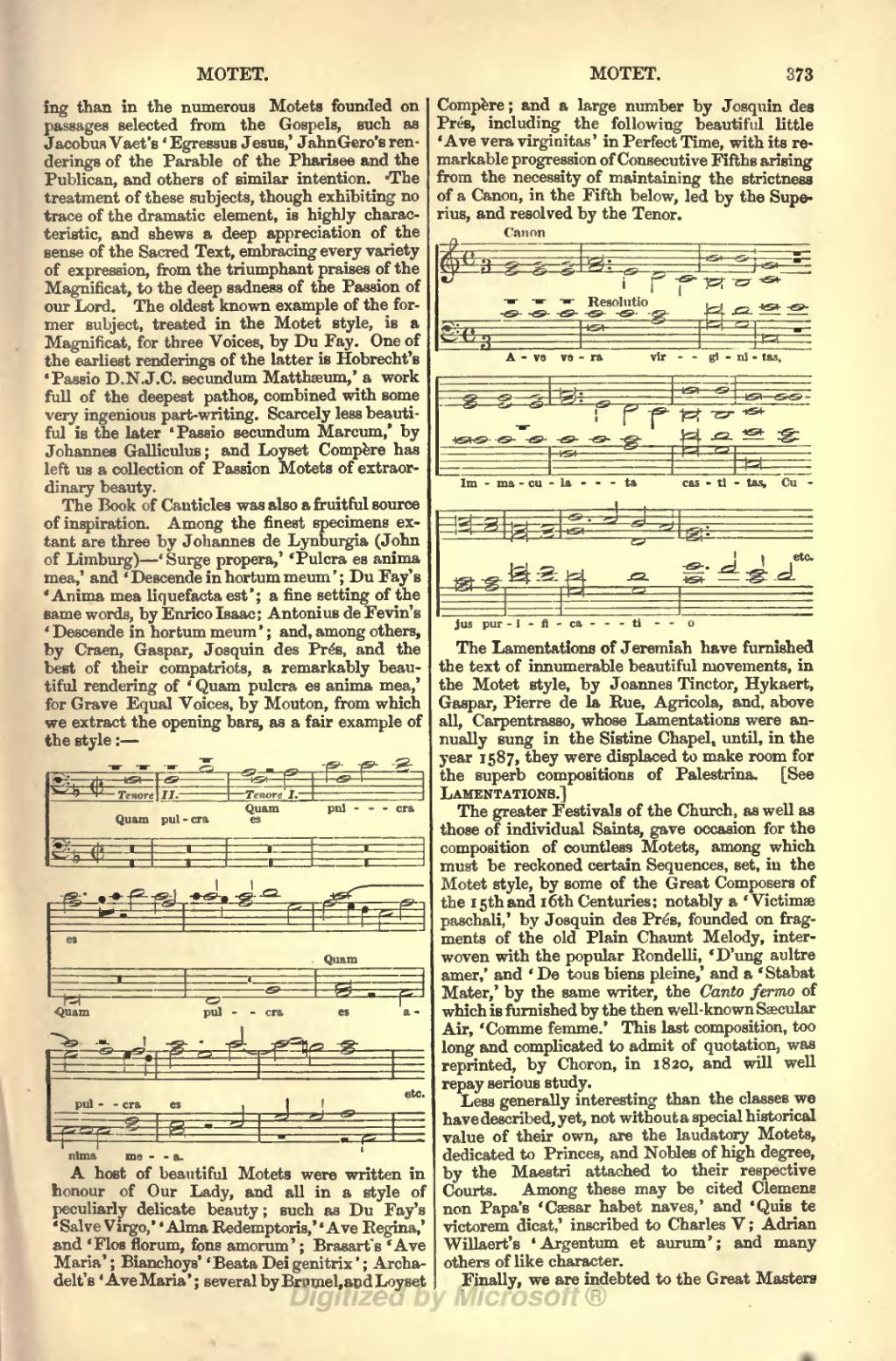ing than in the numerous Motets founded on passages selected from the Gospels, such as Jacobus Vaet's 'Egressus Jesus,' Jahn Gero's renderings of the Parable of the Pharisee and the Publican, and others of similar intention. The treatment of these subjects, though exhibiting no trace of the dramatic element, is highly characteristic, and shews a deep appreciation of the sense of the Sacred Text, embracing every variety of expression, from the triumphant praises of the Magnificat, to the deep sadness of the Passion of our Lord. The oldest known example of the former subject, treated in the Motet style, is a Magnificat, for three Voices, by Du Fay. One of the earliest renderings of the latter is Hobrecht's 'Passio D.N.J.C. secundum Matthæum,' a work full of the deepest pathos, combined with some very ingenious part-writing. Scarcely less beautiful is the later 'Passio secundum Marcum,' by Johannes Galliculus; and Loyset Compère has left us a collection of Passion Motets of extraordinary beauty.
The Book of Canticles was also a fruitful source of inspiration. Among the finest specimens extant are three by Johannes de Lynburgia (John of Limburg)—'Surge propera,' 'Pulcra es anima mea,' and 'Descende in hortum meum'; Du Fay's 'Anima mea liquefacta est'; a fine setting of the same words, by Enrico Isaac; Antonius de Fevin's 'Descende in hortum meum'; and, among others, by Craen, Gaspar, Josquin des Prés, and the best of their compatriots, a remarkably beautiful rendering of 'Quam pulcra es anima mea,' for Grave Equal Voices, by Mouton, from which we extract the opening bars, as a fair example of the style:—
![{ << \new Staff { \time 4/2 \clef bass \key f \major << \new Voice = "T1" \relative f { \stemUp r1 r r r f\breve_\markup { \smaller \italic "Tenore I." } f1 bes |
a r2 a | c c d1 | c\breve ~ | c1 r2 a | c1. c2 | d1 c s4_"etc." }
\new Voice = "T2" \relative f { \stemDown f\breve_\markup { \smaller \italic "Tenore II." } f1 bes | a1 r2 a | c c d1 | c2. bes8[ c] d2 c | c4 bes a1 g2 | a g4 f e2 a | g a1 g4 f | a2 g1 c2 ~ | c b a1 } >> }
\new Lyrics \lyricsto "T1" { Quam pul -- cra es }
\new Lyrics \lyricsto "T2" { Quam pul -- cra es }
\new Staff { \clef bass \key f \major << \new Voice = "B1" { \stemUp R\breve*6 c\breve c1 f e r2 e | g g a1 | s4 }
\new Voice = "B2" \relative f, { \stemDown R\breve*4 f\breve f1 bes | a r2 a | c c d1 | c\breve | r1 r2 a }
\new Lyrics \lyricsto "B1" { Quam pul -- cra es }
\new Lyrics \lyricsto "B2" { Quam pul -- cra es a -- ni -- ma me -- a. } >> } >> }](http://upload.wikimedia.org/score/m/4/m4js6bv8neq0n9xvhph5suwi6n29syr/m4js6bv8.png)
A host of beautiful Motets were written in honour of Our Lady, and all in a style of peculiarly delicate beauty; such as Du Fay's 'Salve Virgo,' 'Alma Redemptoris,' 'Ave Regina,' and 'Flos florum, fons amorum'; Brasart's 'Ave Maria'; Bianchoys' 'Beata Dei genitrix'; Archadelt's 'Ave Maria'; several by Brumel, and Loyset Compère; and a large number by Josquin des Prés, including the following beautiful little 'Ave vera virginitas' in Perfect Time, with its remarkable progression of Consecutive Fifths arising from the necessity of maintaining the strictness of a Canon, in the Fifth below, led by the Superius, and resolved by the Tenor.

The Lamentations of Jeremiah have furnished the text of innumerable beautiful movements, in the Motet style, by Joannes Tinctor, Hykaert, Gaspar, Pierre de la Rue, Agricola, and, above all, Carpentrasso, whose Lamentations were annually sung in the Sistine Chapel, until, in the year 1587, they were displaced to make room for the superb compositions of Palestrina. [See Lamentations.]
The greater Festivals of the Church, as well as those of individual Saints, gave occasion for the composition of countless Motets, among which must be reckoned certain Sequences, set, in the Motet style, by some of the Great Composers of the 15th and 16th Centuries; notably a 'Victimæ paschali,' by Josquin des Prés, founded on fragments of the old Plain Chaunt Melody, interwoven with the popular Rondelli, 'D'ung aultre amer,' and 'De tous biens pleine,' and a 'Stabat Mater,' by the same writer, the Canto fermo of which is furnished by the then well-known Sæcular Air, 'Comme femme.' This last composition, too long and complicated to admit of quotation, was reprinted, by Choron, in 1820, and will well repay serious study.
Less generally interesting than the classes we have described, yet, not without a special historical value of their own, are the laudatory Motets, dedicated to Princes, and Nobles of high degree, by the Maestri attached to their respective Courts. Among these may be cited Clemens non Papa's 'Cæsar habet naves,' and 'Quis te victorem dicat,' inscribed to Charles V; Adrian Willaert's ' Argentum et aurum'; and many others of like character.
Finally, we are indebted to the Great Masters
